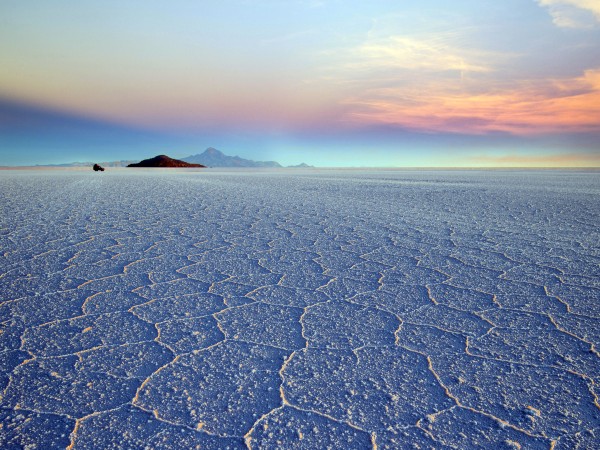Cradled between the eastern and western ranges, or cordilleras, of the Andes mountains, is a series of high plateaus stretching some 1500 miles (2400km) from central Peru into Argentina. Nowhere do they drop below 10,000ft (3000m), and generally they lie much higher. It is a strange run of the country in which nothing is quite what it seems, a little topsy-turvy. The sun burns, yet the deserts on which it shines are rather than blue, and at night the stars do not twinkle but glow in a pall of velvety blackness.

Distant mountains seem almost close enough to touch, and lake water can be any colour from jade green to rosy red, sometimes with water life to match. Or what first appears to be a lake may not be water at all, but a dazzling plain of salt. Ass to this clumps of sullenly smoking volcanoes, pools of bubbling mud, and rocks eroded into the shapes of nightmare beasts, and the picture begins to look familiar. It is an old-fashioned sci-fi illustrator's idea of the surface of Mars.
High And Dry

The overwhelming thing about the plateaus though is their sheer scale. The Altiplano - the 'high plain' between the two arms of the Andes in Bolivia and south of the Andes in western Bolivia and south-east Peru - Lies below peaks that have been awarded no more than a light dusting of snow by the dry air, although they are pushing up towards 20,000ft (6000m) above sea level. Towards the end of the last Ice Age, the Altiplano was covered by two huge lakes Titicaca, vast though it is, is just a tiny remaining fragment of the northern one.
Both lakes were fed by run-off from glaciers and snowfields in the cordilleras, but when the ice retreated and the water supply decreased, the lakes began to evaporate. In the burning sun and clear atmosphere of those high altitudes, the process was relatively swift. Now nothing remains of the southern lake but some brackish lagoons and marshes - these and the slat lakes, or salars, king among them being the awesome Salar de Uyuni.

For most of the time, this salt lake is a blinding plain of pure white salt extending over an area about the size of Cyprus. Ever since the death of the Ice age lake some 10,000 years ago, the process of evaporation has been sucking up moisture and minerals to Uyuni's surface from the mud below. Each year, winter rains form a large shallow lake which evaporates during the summer. All this evaporation creates a crust of minerals, chiefly salt, up to 20ft (6m) deep. Except at the edges, that is, where it is thin enough to collapse and deposit the unwary into the sludge below.
To drive a more rugged kind of car across the salt lake is one of the world's great driving experiences, as well as being a considerable shortcut across the plateau. You take to the salt by one of the safe entrances marked by long-distance truckers, line up on some far-away peak and, in theory, simply go. In fact, the great white plain tends to disorientate direction, and mountain tops seem to float up into the sky. After the rain, it is even worse. The film of water overlying the salt reflects the blue sky, the horizon vanishes, and drivers start to feel as though they are ants sliding across the face of a gigantic mirror.



 Click it and Unblock the Notifications
Click it and Unblock the Notifications























